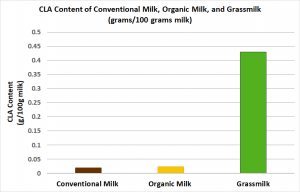- Why This Study and Key Findings
- Health Effects
- Impacts of Dairy Rations and Grazing on Milk Quality
- Nutrition Modeling Results
- CROPP Roll and Funding
Why This Study and Key Findings
Why this study?
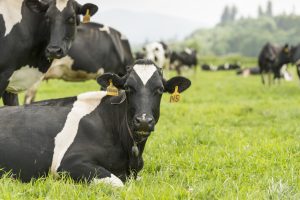
Milk and dairy products are excellent and affordable sources of many essential nutrients, and also contain a much healthier balance of fatty acids than most other major foods.
In the U.S. population, excessive intakes of omega-6 fatty acids relative to omega-3 fatty acids tend to promote heart disease and other health problems.
Increasing omega-3 intakes will also help combat inflammation, promote heart health, and are critical for healthy pregnancies and the development of children.
Two main goals shaped the study.
First, we wanted to determine whether, and to what degree the fatty-acid related nutritional quality of milk is altered when lactating dairy cows are fed an essentially 100% grass and legume-forage based diet.
And second, might the changes in the fatty acid profile of grassmilk alter the overall nutritional quality of typical American diets?
What is an “essentially” 100% forage-based diet?
Throughout the paper, we refer to an “essentially 100% forage-based diet” for lactating dairy cows, or “nearly a 100% forage-based diet.” While the vast majority of daily feed by weight is derived from grass and legume-forages on grassmilk farms, cows need certain minerals, vitamins, and energy-dense feeds, like sugar beets and molasses, to retain body condition during lactation.
Most grassmilk certification standards also allow the feeding of grains during their vegetative stage, when their omega-6 to omega-3 balance is similar to, or even better than grass and legume forages.
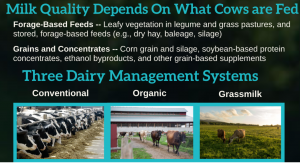
Is it unusual for dairy farmers to feed lactating dairy cows nearly 100% forage-based feed?
Yes, very unusual. Cows fed an essentially 100% forage-based diet do not produce as much milk per day as cows fed high-energy feeds containing corn, soybeans, and other feed grains.
But when given access to well-managed, high-quality forages, grazing cows on grassmilk farms can meet their nutritional needs at much lower cost compared to farms feeding 30% to 50% of daily Dry Matter Intake (DMI) from grains and concentrates. While some conventional and organic dairy farms have cut back on grain and concentrates to lower costs and improve cow health, it is unusual for forage-based feeds to make up more than 80% of average DMI throughout a cow’s lactation, and it is very unusual for farmers to take the last step in eliminating all grains and grain-based concentrates.
What did you compare grassmilk to?
We compared the fatty acid profile of milk from cows managed under three systems:
- “Grassmilk” cows receive a nearly 100% grass and legume forage-based diet, via pasture and stored feeds like hay and silage. Only a fraction of 1% of dairy cows on U.S. farms receive 100% forage-based feeds.
- “Organic” cows receive, on average, about 80% of their daily Dry Matter Intake (DMI) from forage-based feeds and 20% from grain and concentrates. Cows managed on organic farms produce enough milk to account for 7% to 8% of dairy product sales in the U.S.
- “Conventional” cows are fed rations in which forage-based feeds account for an estimated 53% of daily DMI, with the other 47% coming from grains and concentrates. Conventional management accounts for over 90% of the milk cows on U.S. farms.
What did you learn?
There are no significant differences across the three dairy management systems in terms of total saturated and total monounsaturated fatty acids in milk and dairy products, but there are big differences in the levels of key polyunsaturated fatty acids (PUFAs).
What are the key differences in the omega-6 and omega-3 levels in milk?
In our 2013 PLOS ONE paper we documented big differences in PUFA levels between conventional and organic milk. In this paper, we report surprisingly significant differences between organic milk and 100% grassmilk, and hence even greater differences between grassmilk and conventional milk.
How did omega-3 fatty acid levels differ?
Whole fat grassmilk has the highest level of omega-3 fatty acids – 0.05 grams of omega-3 per 100 grams of milk (g/100 g). Organic milk contains 0.03 g/100 g, and conventional milk has 0.02 (see chart to the right). So, organic milk had about 50% more total omega-3 than conventional milk, and grassmilk had about 50% more omega-3 than organic milk. The biggest difference is between grassmilk and conventional milk – omega-3 levels in grassmilk are about 2.5-times higher than in conventional milk.
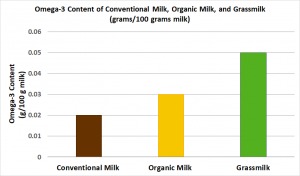
How did omega-6 fatty acid levels differ?
Conventional milk has the highest level of total omega-6 fatty acids, on average 0.095 g/100 g milk. Organic milk contains 0.07 g/100 gram, or about 26% less than conventional milk.
Of the three management systems, grassmilk has the lowest concentration of omega-6 fatty acids, 0.045 g/100 gram, which is 36% less than organic milk and 52% less than conventional milk.
So, conventional milk has about twice the level of omega-6 fatty acids compared to grassmilk, and grassmilk has about 36% less omega-6 than organic milk.

What about the omega-6 to omega-3 ratio?
Conventional milk contains an omega-6 to omega-3 ratio of 5.7 to 1 (or just 5.7), whereas organic has a much healthier balance of fatty acids — 2.3 to 1.
While both conventional and organic milk helps lower a person’s overall, dietary omega-6 to omega-3 ratio, organic milk does so more significantly.
In one of our study’s most important findings, grassmilk lowers this key ratio to 0.95, actually reducing omega-6 intake levels to just below the level of omega-3s!
Why should people care about balanced intakes of omega-6 and omega-3 fatty acids?
Human beings evolved with a diet containing roughly equal intakes of omega-6 and omega-3 intakes. Starting in the 1940s, the typical U.S. diet contained incrementally more omega-6 fatty acid, and gradually less omega-3 fatty acid.
As the balance becomes more highly skewed, the risk of a variety of diet-related, chronic diseases goes up.
Today on average, Americans consume 15 grams of omega-6 for every gram of omega-3, a pattern of PUFA intake that clearly contributes to the risk of overweight and obesity, diabetes, cardiovascular disease, and a number of other health problems.
What about Conjugated Linoleic Acid (CLA)?
CLA is a heart-healthy fatty acid that also promotes good immune system health. Most Americans will benefit from increased, daily CLA intakes. Most of the CLA in the diet comes from animal products, particularly dairy products and meat. The CLA levels in milk, meat, and eggs is directly linked to the amount and quality of forage-based feeds in animal rations.
Grassmilk has by far the highest average, year-round level of CLA – 0.43 g/100 g of milk, compared to 0.019 g/ 100 g in conventional milk. The level in organic milk fell between these two values, but closer to conventional milk, at a level of 0.023 g/ 100g.
This pattern in the level of CLA in the three types of milk was a second surprise.
The level of CLA in organic versus conventional milk was only 18% higher, despite the big increase in the percent of forage-based feeds in daily DMI on organic farms compared to conventional farms — 80% forage-based DMI on organic farms versus about 53% on conventional farms.
The flip side of this big difference in reliance on forage-based on organic farms is relative reliance on grains and concentrates as a portion of daily DMI – on conventional farms, 47% of DMI comes from grains and concentrates, while grains and concentrates account for just 20% of DMI on the average organic farms.
By shifting away from any grains and concentrates to essentially 100% forage-based feed, grassmilk farms had a much bigger impact on CLA levels than we expected.
The shift from 80% to 100% forage-based feeds on grassmilk farms boosted annual, average CLA levels to 0.043 g/ 100 g of whole milk, a level 90% higher than in organic whole milk and 2.2-fold the level in whole milk from cows on conventional farms.
Why are CLA levels higher in organic and grassmilk?
CLA levels in milk are closely associated with the amount and quality of grasses and legumes in a lactating cow’s daily diet.
For this reason, the CLA level in milk is a reliable indicator of reliance on forage-based feeds. In our study, the differences in CLA levels were dramatic and generally consistent across the U.S.
Health Effects
Why should people pay attention to PUFA intakes?
There are two major categories of essential PUFAs: omega-3 and omega-6 fatty acids. Both are “essential” because they are necessary to sustain cell integrity and health. Plus, we must get them from our diet, since our bodies cannot synthesize them.
(See our “Primer on Fatty Acids in Milk” for how omega-3 fatty acids differ structurally from omega-6s, an overview of the remarkable diversity of health effects associated with different fatty acids, and how the very important long-chain PUFAs are biosynthesized from omega-3 and omega-6 fatty acids).
Each day, most people consume about 15 grams of omega-6 for every 1 gram of omega-3, resulting in an unbalanced omega-6 to omega-3 intakes. The general consensus among nutritionists is that people need to first and foremost focus on increasing their omega-3 intakes to bring about a healthier balance of PUFA intakes.

People who never or rarely eat fish, and frequently consume fried and processed foods, are likely to consume 20 or more grams of omega-6 for each gram of omega-3.
For this segment of the population, adoption of some simple strategies to lower omega-6 intakes should also be considered. For example – switching from conventional milk and cheese to grassmilk dairy products, from potato chips to pita chips, or from soybean oil to canola oil.
Why do high omega-6 to omega-3 intakes erode public health?
Today’s imbalance in omega 6 intakes relative to omega-3 heightens the risk of cardiovascular disease, diabetes, overweight and obesity, several forms of cancer (especially breast, prostrate, and colon cancers), and problems with our eyes. It also can impair bone health and alter behavior and neurological health in several ways.
What are the major omega-3 fatty acids in food?
Alpha-linolenic acid, or ALA (18:3 α-linolenic), is by far the major omega-3 fatty acid in most foods. Our paper reports that ALA accounts for about 78% of the total omega-3 fatty acids

in grassmilk, and about 80% of total omega-3 fatty acids in conventional milk.
ALA accounts for similarly high percentages of total omega-3 fatty acids in most animal products (beef, eggs, pork), as well as in most plant-based sources of omega-3s (e.g., flaxseed, walnuts, tofu). Fish is the major exception – explained below.
There are three important (to health) long-chain, omega-3s – EPA (20:5 eicosapentaeonic acid), DPA (22:5 docosapentaeonic acid), and DHA (22:6 docosahexanoic acid).
In grassmilk, the three long-chain, omega 3 PUFAs account for 0.0092 g/100 g milk, or about 19% of total omega-3 fatty acid content.
Conventional milk delivers about 0.0062 g/100 g milk, about one-third less than grassmilk
Note: the NIH has an excellent fact sheet on omega-3 fatty acids for health professionals.
Why are the long-chain omega-3 PUFAs so important?
These long-chain, omega-3 PUFAs play many vital roles in our health, from birth to death, despite their presence at very low levels in a relatively few foods.
Our daily needs for EPA, DPA, and DHA vary at different life stages and as a function of health status and our unique genetics. But limited data suggest that most people need to at least triple daily intakes to achieve all the health benefits stemming from adequate long-chain PUFA intakes. Increasing intakes are particularly important for pregnant women, breastfeed babies, and children through about age 16.
What are good sources of long-chain PUFAs?
Most people depend on a mix of EPA, DPA, and DHA intakes from food, beverages, and dietary supplements (especially fish oil capsules). Our bodies can also endogenously synthesize these long-chain fatty acids from daily ingestion of the major omega-3 in the diet, ALA.
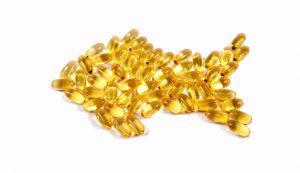
The human body can convert ALA first to EPA, then to DPA, and last to DHA, and strives to carry out these biochemical transformations proportional to the body’s need for long-chain PUFAs.
The lower a person’s dietary intake of EPA, DPA, and DHA, the more a person relies on their dietary intake of ALA, and the efficiency of their body’s transformation of ALA to EPA, DPA, and DHA.
What are the health effects of omega-3 fatty acids?
Inadequate omega-3 intakes increase the risk of coronary heart disease, asthma, type 1 diabetes mellitus, multiple sclerosis, certain cancers, inflammatory bowel disease, rheumatoid arthritis, and psoriasis.
The magnitude of risk is a function of omega-3 intake levels relative to omega-6 intakes (mechanisms explained below), the age of an individual, overall health status, and a person’s genetics.
Several genetic polymorphisms increase or decrease the impact of inadequate omega-3 intakes and/or imbalanced omega-3 to omega-6 intakes.
What foods are good sources of the major omega-3 fatty acid ALA?
In roughly descending amounts of ALA per typical serving, foods that are good sources of ALA include flax seeds, walnuts, tofu, soy and canola oils, whole milk, Cheddar cheese, navy beans, some leafy greens, mango, cauliflower, and wild Atlantic salmon (not most farmed-raised salmon).
What about omega-6 fatty acids?
The body needs both omega-3s and omega-6s to sustain a diversity of physiological and metabolic functions. Intakes of omega-6 fatty acids are correlated with arthritis, inflammation, CVD, and cancer. Omega-6 fatty acids also contribute to the developing nervous system and brain in children, and are key in sustaining brain function throughout life.
Omega-6s play a role in skin and hair growth, and bone and reproductive system health. They also help regulate metabolism, and can reduce nerve pain.

Where are all the omega-6s coming from in the typical U.S. diet?
The biggest source of omega-6s in the diet are foods fried in, or cooked with corn or soybean oil, and sauces and dressings containing these oils. Other important sources include grain-fed beef and pork, chicken and eggs, milk from cows fed a lot of corn, nuts, and other plant-based foods.
What role does CLA play in promoting human health?
CLA is a nutrition super-star that lowers the risk of several chronic disease. A recent meta-analysis cites the following health benefits of linked to the CLA content in milk: lower risk of obesity, diabetes, cancer, CVD, and hypertension. CLA intake also promotes improved immune system function and bone formation and strength.
Clearly, CLA somehow guards against what physicians call the “metabolic syndrome,” and dairy products are a major source of CLA in the U.S. diet.
Why does the omega-6 to omega-3 ratio matter?
It is complicated to study the health effects of omega-6 and omega-3 fatty acid levels, both in specific foods and daily diets. This is because so many foods contain both, and many factors influence how our bodies utilize different fatty acids.
When omega-6 intakes rise well above omega-3 intakes, this imbalance in omega fatty acid intakes leads to yet another set of impacts on health and chronic disease. In such cases, scientists lack the tools to isolate whether it is the increase in omega-6 levels by itself, or changes in omega-3 levels, or the generally rising ratio of omega-6 to omega-3 fatty acids that account for changes in health status.
Depending upon the health endpoint of concern, studies suggest that an omega-6 to omega-3 ratio between 4 and 2 would minimize the risk of adverse health outcomes ranging from cardiovascular disease and metabolic problems, to erosion of bone density, eye problems, and certain cancers.
With contemporary omega 6 to omega 3 ratios running at about 15 to 1, there is a huge need – and a lot of room for — improvement in this key metric.
Impacts of Dairy Rations and Grazing on Milk Quality
You say that dairy farms feeding an essentially 100% forage-based feed are unusual, and represent less than 1% of all dairy farms. Does this mean that such farms are not economically viable?
No, definitely not. In fact, most dairy farms around the world feed lactating cows forage-based diets with relatively little, or no grain. Especially in regions with ample rainfall spread throughout the year, and mild climates that support the growth of grasses and legumes in 10 or more months of the year, the cost of producing milk with nearly 100% forage-based feeds is lower than milk from cows feed grain and concentrates.
But doesn’t adding grain to dairy rations increase production?
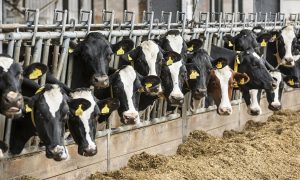
Yes, it surely does. The dominant goal in dairy farm research and technology development in the U.S. over the last 50 years has been increasing daily average milk production per cow.
This has shifted the genetics of the U.S. dairy herd to the Holstein breed, and has led to what is called Total Mixed Rations (TMRs) with as much high-energy grain and concentrate as a cow can ingest without triggering health problems.
The majority of dairy cows is now fed relative “hot” (i.e., high energy) rations composed of around 50% grains and concentrates. Such rations support high-levels of production and have made it possible for dairy farmers to more than double average daily milk production per cow since the 1970s. But steady progress in boosting daily milk production has come at a cost.
What else happens as dairy cows are fed more corn and grain-based supplements and less forage?
There are several consequences. The changes in cow rations and management required to boost production have lowered both the average protein level and butterfat level in milk by about 1% (from ~4% to ~3%). Vitamin D and antioxidant levels have also fallen.
High-producing cows are also harder to rebred and face a number of health problems stemming from the unnaturally “hot” diet they are fed (cows evolved on a 100% forage-based diet). As the share of grain in a cow’s ration rises, the acidity in her rumen rises, which can lead to a variety of cow health problems that have cut the number of lactations during an average cow’s life over the last one-half century from around five to less than two.
This is a major reason why the dairy industry, and cow welfare, will benefit from an incremental downward shift in the percent of daily DMI from grain and concentrates, coupled with incrementally greater reliance on forage-based feeds.
Major benefits for the industry, cow health, and the nutritional quality of dairy products can be achieved far short of converting the entire dairy industry to 100% forage-based feed.
Nutrition Modeling Results
Dietitians are taught that “milk is milk,” or “beef is beef,” but an animal’s diet has a surprisingly significant impact on the nutritional quality of milk and meat.
Fatty fish from cold water (salmon, mackerel, herring) provide a rich source of the long-chain omega-3 fatty acids, DHA and EPA, and dietitians are aware that flax seeds and walnuts are among the good plant sources of ALA. But most dietitians don’t consider that meat and dairy products from largely grass-fed animals can also contribute higher intakes of omega-3 fatty acids and a healthier balance in omega-6 and omega-3 intakes.
How did you model the impact of the fatty acid profiles of grassmilk, organic milk, and conventional milk?

We modeled a typical daily diet of a healthy, 30-year old woman. About two-dozens distinct foods were consumed during breakfast, lunch, and dinner, and two snacks.
We drew upon USDA data on the LA (major omega-6) and ALA (Major omega-3) content in the two-dozen foods to calculate overall, daily LA and ALA intakes. The LA/ALA ration served as a proxy for the omega-6 to omega-3 ratio.
We then calculated changes in LA and ALA intakes brought about by three dietary interventions: shifting from conventional to organic to grassmilk dairy products; increasing average daily dairy product intakes from 3 servings to 4.5 servings per day; and, replacing three foods high in LA content with three similar foods that were much lower in LA content (e.g., pita chips instead of tortilla chips; canola oil instead of soybean oil; canola margarine instead of regular margarine).
What did the modeling results show?
The baseline daily diet had an LA to ALA ratio of 11.3, a bit below the average across the U.S. population, but well above optimal levels.
Switching from conventional dairy products to grassmilk dairy products lowered the LA/ALA ratio to 8.6, a healthy 24% reduction.
Adding 1.5 additional servings of grassmilk dairy products (raising daily intakes from 3 to 4.5 servings) lowers the ratio to 6, a 47% reduction.
Choosing three foods relatively low in LA, compared to similar foods made with or fried in corn or soybean oil, in addition to 3 servings of grassmilk dairy products, reduces the ratio to 4, an impressive 65% reduction.
All three interventions together – switch to grassmilk dairy, 4.5 instead of 3 servings of dairy products daily, and seeking out three low-LA alternative foods – lowers the LA/ALA ratio all the way to 3.14, a decline of 72% and clearly within the heart-health zone.
In the three intervention scenario, the decline in omega-6 intakes accounts for about two-thirds of the drop in the LA/ALA ratio, with the remaining one-third driven by the approximate 45% increase in total omega-3 intake.
How does grassmilk compare to fish as a source of omega-3 fatty acids?
Ounce for ounce, fish, and especially oily fish, is a superior source of long-chain omega-3 fatty acids. But fish does not contribute significantly to overall omega-3 intakes across the U.S. population.
Why? Only about 30% of Americans eat fish, and a smaller percentage eat it regularly.
Second, fish contains relatively low levels of the major omega-6 in food (LA), as well as the major omega-3 in food (ALA).
Plus, omega-3 levels in most farm-raised fish are much lower than in wild fish, because of the corn and soybeans, and other plant-based feeds, mixed into the rations fed to most farm-raised fish. Grain-based fish rations are cheaper, and contain the building blocks of omega-6 fatty acids, not omega-3s.
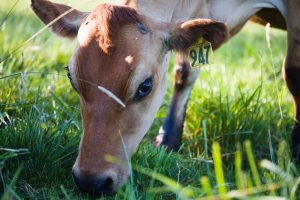
Is there a common theme linking the nutritional quality of milk and fish?
Yes. Just as in the case of grain-fed, farm-raised fish, the diet of lactating cows has a big impact on the omega-3 content of dairy products. Cows on grassmilk farms receive nearly 100% of their daily Dry Matter Intake from forage-based feeds, while cows on a typical conventional farm receive about 47% of their daily DMI from grains and concentrate feeds high in LA and low in ALA.
As a result, a serving of whole grassmilk contains 0.049 grams of omega-3 fatty acids per 100 grams of milk, whereas milk from conventionally managed cows contains only 0.02, or less than one-half the level in grassmilk. In addition, there is about one-third more of the long-chain omega-3 fatty acids EPA and DPA in grassmilk, compared to conventional milk.
CROPP Role and Funding
Your study analyzed the complete fatty acid profile of over 1,100 samples of grassmilk. Where did this huge dataset come from?

Grassmilk samples came from approximately bi-monthly testing of bulk tank (farm-level) samples from farms producing grassmilk in accord with the production standards set forth by Organic Valley. In 2016, about 140 farms shipped essentially 100% grassmilk under the Organic Valley label.
Grassmilk sample testing was done by Silliker, Inc in 2014-2016 and paid for by CROPP, the organic coop that sells Organic Valley brand dairy products and Organic Prairie meat products.
The testing cost about $120 per sample counting collection, shipping, and Silliker lab fees, for a total investment of about $132,000.00.
Why did CROPP test so many samples?
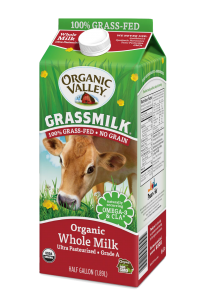
In 2013 CROPP and Organic Valley decided to begin national marketing of Grassmilk® from cows fed an essentially 100% forage-based diet. The Coop developed a set of feeding and cow management standards for its farmer-members, all of whom were eligible to join the voluntary grassmilk program.
To assure compliance with the grassmilk program’s cow feeding and milk nutritional quality requirements, Organic Valley put in place a rigorous grassmilk testing program.
Regional thresholds were set for omega-3, omega-6, and CLA levels in grassmilk. The thresholds were based on the patterns of fatty acid levels evident in the large number of milk samples OV had tested over the previous five-plus years, including milk from farms feeding cows 100% forage-based feeds before the Grassmilk brand was launched.
Before a farm was allowed into the grassmilk program, OV sent samples of milk from the farm’s bulk tank for testing by Silliker, Inc., to confirm adherence to OV’s internal nutritional quality specifications. Once on the grassmilk truck, samples were typically taken of each farm’s milk every two months.
Over time, the number of samples of grassmilk tested though CROPP’s routine quality control monitoring grew. The rising number of samples from year to year reflects growth in the number of farmers joining the grassmilk program.
Today, there are about 1,620 farmers shipping their milk through the Organic Valley brand, so grassmilk farmers account for about 9% of the total farmer-membership of CROPP.
Who paid for the study and how much did it cost?
CROPP/OV paid for the collection and testing of grassmilk samples, at a total cost of about $132,000. This expenditure was budgeted, and invested in assuring that marketed, OV brand Grassmilk met the fatty acid-based nutritional quality specifications discussed above.
CROPP also provided a research grant of $50,000 to Benbrook Consulting Services to cover the work done on the analysis and paper by co-authors Chuck Benbrook and Don Davis. The time and expenses incurred by the other five co-authors working for a university were covered via a variety of university grants and contracts not involving CROPP/OV.
Additional financial support from CROPP covered the salary of the three paper co-authors who are full-time employees of CROPP — Maged Latif (runs OV’s testing and quality control programs), Logan Peterman (heads CROPP’s research activities and managed the grassmilk standards development process), and Silvia Abel-Caines (OV’s dairy nutrition and grazing management specialist).
The total cost of data collection and testing, the analytical work, staff salaries, preparation of the paper, and the publication process was about $200,000.
But why the huge investment by CROPP in grassmilk, and why in 2014?
CROPP and Organic Valley dairy farmers have always been committed to cow health. Experience shows that allowing lactating cows to graze well-managed pastures is among the best and most affordable ways to promote cow health, while also lowering production costs.
Grazing nutritious pasture also produces nutritionally-enhanced milk, i.e. milk with higher protein and butterfat levels, more Vitamin D and antioxidants, and a better balance of essential fats, compared to milk from cows fed significant corn, soybeans, and other grain concentrates.
So, CROPP decided in 2013 to launch a national Grassmilk brand, and hoped the testing of its grassmilk products would help prove what their farmer-members have always intuitively felt — that pasture and high quality forage makes for healthier milk.
Other than providing financial and staff support, what other roles did CROPP/OV play in the study?
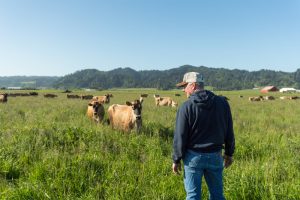
Several important ones. The fatty acid profile data collection and management job was a big one to which CROPP technical staff made huge contributions.
The study would not have been possible without the hard work and perseverance of 140+ CROPP grassmilk dairy farmers. In the published paper, the co-authors write:
“We also acknowledge and honor the commitment and skill of the grassmilk farmers in CROPP, all of whom faced a raft of challenges in converting their operations to 100% forage-based feed.”
The co-authors also benefited from our ability to draw on the collected experience of the Coop and its members in grazing management, cow health, and milk quality.
Are you worried that CROPP/OV’s role in the study will led some people to question the results?
Yes, we are. There is a presumption today that “industry” funded research is usually tainted by clever to overt bias.
The journal Food Science and Nutrition has extensive and rigorous policies calling for full disclosure of potential competing interests, as well as disclosure of funding sources. We complied with each.
The team’s financial disclosure states —
“Support for CMB and DRD was provided by CROPP Cooperative via a research grant (no grant No.) to Benbrook Consulting Services, which paid DRD as a consultant. CROPP Cooperative, La Farge, Wisconsin paid for testing the milk samples and the salaries of MAL, LP, and SA-C. Through these employees the funder played a role in the study design, data collection, and decision to publish. They played no role in the data analysis and minimal role in the preparation of the manuscript.
Support for CL, GB and MB came from:
- The EU-LowInputBreeds project (grant No. 222623),This funder played no role in the study design, data collection and analysis, decision to publish, or preparation of the manuscript.
- DEFRA’s Sustainable Intensification Research Platform (no grant No.), This funder played no role in the study design, data collection and analysis, decision to publish, or preparation of the manuscript.
- A Personal Fellowship grant for CL from the Sheepdrove Trust (no grant No.). This funder played no role in the study design, data collection and analysis, decision to publish, or preparation of the manuscript.
Support for BJH came from the University of Minnesota West Central Research and Outreach Center. This funder played no role in the study design, data collection and analysis, decision to publish, or preparation of the manuscript. BJH performed some of the data analysis.”
On behalf of the team of co-authors, this statement of competing interests was submitted –
“CROPP Cooperative sells grassmilk via its Organic Valley brand. MAL is the Director of Research & Development and Quality Assurance at CROPP Cooperative. LP and SA-C are on the research and technical services staff of CROPP Cooperative. BJH is faculty supervisor of the University of Minnesota West Central Research and Outreach Center organic dairy, which markets its milk through CROPP Cooperative and Organic Valley. CMB was Chief Scientist of The Organic Center, 2005-2012, funded in part by CROPP Cooperative; DRD was a consultant to same center, 2011-2012. CMB was program leader for the Measure to Manage program at Center for Sustaining Agriculture and Natural Resources, Washington State University, 2012-2015, for which CROPP was a funder; DRD was a consultant to the same program, 2012-2015.”

Are such disclosures enough to allay concerns of bias?
Such transparency is essential in scientific publishing.
Choosing to publish, and being able to publish a paper in a high-quality scientific journal, with a rigorous peer-review process, also provides a level of comfort for those skeptical about a given study’s findings.
It is also important to be thorough and accurate in disclosing analytical methods, in discussing the choice of statistical tests, explaining any assumptions made and their justification, and the basis for any findings or conclusions stated.
Sharing raw data and analytical methods and models, so others can replicate your work or explore the impacts of alternative analytical tools, statistical tests, or assumptions, is also important and one key way in which science advances. Our raw data are available from Don Davis or Maged Latif.
Our methods are fully explained in the paper. The team is also glad to share our models and will do so by request (contact charlesbenbrook@gmail.com).
Did you try to raise funding from government research agencies or foundations to support this work?
Several co-authors have been part of multiple proposals to USDA competitive research grant programs to support this sort of dairy farming system-milk nutritional quality work. Most such grants are not successful in receiving funding, no doubt in part because of the high lab costs, and the potential to benefit specific private interests.
CROPP had a good understanding of what their grassmilk fatty acid data showed, but lacked the scientific expertise to analyze the dataset using state-of-the-art methods and models. CROPP reached out to a team of scientists with such skills, and made it possible for the study to be done, and this paper to be written and published in a top-flight journal.
Without support from CROPP, it is hard to imagine how a study like this would be possible. And without such studies, critical insights and important findings will remain beyond the horizon, and the reach of the scientific community.
We hope readers will evaluate the quality of the work and the validity of our findings and conclusions based on the quality of the science, rather than who funded the work. Of course, some will find fault in our work, and may trace unwelcomed findings to the fact we received “industry” funding.
Will the work go on?
Yes. There is growing interest in grass-fed livestock products, both in the U.S. and around the world. Some people seek out grass-fed meat, milk, and poultry products because of nutritional quality benefits, and others prefer the taste of grass-fed products. Many consumers also feel that pasture, grazing, and forage-based feeds are better for the environment and enhance animal welfare.
When valid issues and criticisms are raised about our research, we will work to respond to them and improve the methods, data quality, and rigor in future studies. This is how science advances. Our team and CROPP are committed to moving this important area of science forward, because it is so intimately linked to cow health, milk nutritional quality, and public health.


